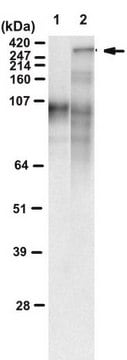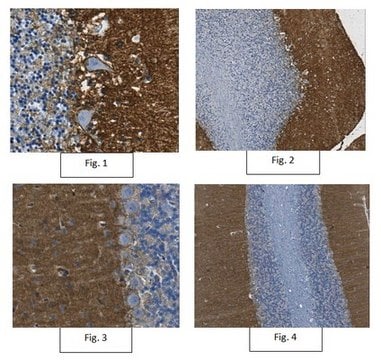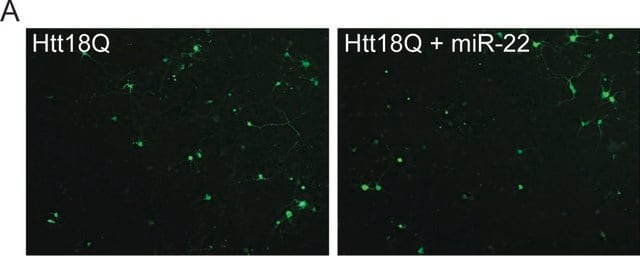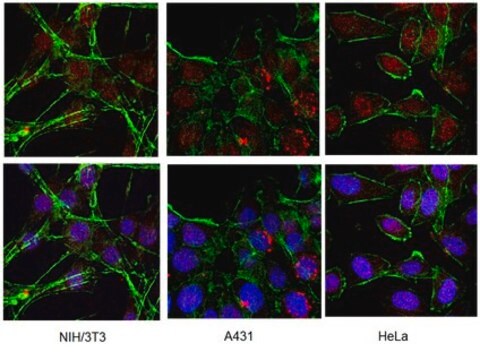추천 제품
생물학적 소스
mouse
Quality Level
항체 형태
purified antibody
항체 생산 유형
primary antibodies
클론
3B5H10, monoclonal
종 반응성
human
기술
electron microscopy: suitable
immunocytochemistry: suitable
immunohistochemistry: suitable
inhibition assay: suitable
western blot: suitable
동형
IgG1
UniProt 수납 번호
배송 상태
ambient
타겟 번역 후 변형
unmodified
유전자 정보
human ... HTT(3064)
일반 설명
Huntingtin (UniProt P42858; also known as HD protein, Huntington disease protein) is encoded by the HTT (also known as HD, IT15) gene (Gene ID 3064) in human. Misfolding and self-aggregation of specific proteins are a common feature of well known neurodegenerative diseases, including Huntington s disease (HD), Alzheimer s disease (AD), Parkinson s disease (PD), and amyotrophic lateral sclerosis (AML). Abnormal polyglutamine (polyQ) repeat sequence or stretch result in protein misfolding and neurodegeneration. HD, for example, is caused by polyQ expansion in the first exon-coded sequence of the causal protein Huntingtin (Htt exon 1). The expanded polyQ leads to formation of beta-sheet rich fibrillar aggregates called amyloid. Eight proteins containing polyQ tracts, but otherwise unrelated to htt, also result in protein misfolding and neurodegeneration upon polyQ expansion. Growing evidences implicate soluble oligomers or even monomers of disease-causing amyloid proteins as the more toxic species. In HD, formation of the end-stage, very large aggregated species of mutant htt (mHtt), termed an inclusion bodies (IBs), is believed to be a coping response to sequester toxic species of monomeric or small oligomeric mHtt, which are distributed diffusely throughout the neuron.
특이성
Clone 3B5H10 targeted epitope is exposed among some of the many conformations adopted by monomeric and possibly small oligomeric polyQ species of mutant Huntingtin protein (mHtt), but disappears in higher-molecular weight aggregated forms, such as inclusion bodies (IBs). The epitope also exists in mutant forms of other polyQ-containing proteins that cause neurodegeneration, including the androgen receptor, atrophin, and ataxin-3 (Miller, J., et al. (2011). Nat. Chem. Biol. 7(12):925-934).
면역원
N-terminally GST-tagged human Huntingtin (Htt) fragment corresponding to exon 1-coded seqeunce containing a stretch of 66 glutamines (GST-171-Q66; Miller, J., et al. (2011). Nat. Chem. Biol. 7(12):925-934).
애플리케이션
Anti-polyQ Disease Proteins, clone 3B5H10, Cat. No. MABN821, is a highly specific mouse monoclonal antibody, that targets disease-associated polyQ proteins and has been tested in Electron Microscopy, Immunocytochemistry, Immunohistochemistry, Inhibition study, and Western Blotting.
Electron Microscopy Analysis: A representative lot immunostained transiently expressed Huntington (Htt) N-terminal fragment with 97 polyQ expansions in transfected neurons. Clone 3B5H10 labeled diffuse Htt in the cytoplasm with little staining of Htt in organelles and no staining of Htt in large inclusion bodies (IBs) (Miller, J., et al. (2011). Nat. Chem. Biol. 7(12):925-934).
Immunocytochemistry Analysis: A representative lot immunostained neurons transiently expressing Huntington (Htt) or Ataxin-3 with disease-associated polyQ expansions (Q46 to Q138), but not neurons expressing Htt with Q17 or Ataxin-3 with Q27. Clone 3B5H10 stained diffuse mutant Htt (mHtt), but not aggregated Htt in large inclusion bodies (IBs) (Miller, J., et al. (2011). Nat. Chem. Biol. 7(12):925-934).
Immunohistochemistry Analysis: A representative lot immunostained brain tissue sections from transgenic mice expressing disease-associated human mutant Huntinton (mHtt) proteins, including murine strains BACHD (full-length mHtt with Q97), R6/2 (Exon 1 fragment with ~Q150), and YAC-SCA3 (full-length mHtt with Q84). Clone 3B5H10 stained diffuse mHtt and failed to stain tissue with extensively aggregated Htt unless strong antigen retrieval by 90% formic acid treatment was performed (Miller, J., et al. (2011). Nat. Chem. Biol. 7(12):925-934).
Inhibition Analysis: A representative lot prevented the aggregation of mutant Htt (mHtt) exon 1 fragment with Q39 or Q53 and disrupted pre-aggregated mHtt oligomers and fibrils into monomer in vitro by atomic force microscopy (AFM) and dynamic light scattering (DLS) measurement (Miller, J., et al. (2011). Nat. Chem. Biol. 7(12):925-934).
Western Blotting Analysis: A representative lot detected Huntington (Htt), androgen receptor (AR), and atrophin constructs with disease-associated polyQ expansions (Q65 to Q103), but not constructs with Q19 or Q25, exogenously expressed in HEK293 and PC12 cells. Clone 3B5H10 detected monomeric and possibly small oligomeric mHtt N-terminal fragments, but not large oligomers or high molecular weight aggregates (Miller, J., et al. (2011). Nat. Chem. Biol. 7(12):925-934).
Immunocytochemistry Analysis: A representative lot immunostained neurons transiently expressing Huntington (Htt) or Ataxin-3 with disease-associated polyQ expansions (Q46 to Q138), but not neurons expressing Htt with Q17 or Ataxin-3 with Q27. Clone 3B5H10 stained diffuse mutant Htt (mHtt), but not aggregated Htt in large inclusion bodies (IBs) (Miller, J., et al. (2011). Nat. Chem. Biol. 7(12):925-934).
Immunohistochemistry Analysis: A representative lot immunostained brain tissue sections from transgenic mice expressing disease-associated human mutant Huntinton (mHtt) proteins, including murine strains BACHD (full-length mHtt with Q97), R6/2 (Exon 1 fragment with ~Q150), and YAC-SCA3 (full-length mHtt with Q84). Clone 3B5H10 stained diffuse mHtt and failed to stain tissue with extensively aggregated Htt unless strong antigen retrieval by 90% formic acid treatment was performed (Miller, J., et al. (2011). Nat. Chem. Biol. 7(12):925-934).
Inhibition Analysis: A representative lot prevented the aggregation of mutant Htt (mHtt) exon 1 fragment with Q39 or Q53 and disrupted pre-aggregated mHtt oligomers and fibrils into monomer in vitro by atomic force microscopy (AFM) and dynamic light scattering (DLS) measurement (Miller, J., et al. (2011). Nat. Chem. Biol. 7(12):925-934).
Western Blotting Analysis: A representative lot detected Huntington (Htt), androgen receptor (AR), and atrophin constructs with disease-associated polyQ expansions (Q65 to Q103), but not constructs with Q19 or Q25, exogenously expressed in HEK293 and PC12 cells. Clone 3B5H10 detected monomeric and possibly small oligomeric mHtt N-terminal fragments, but not large oligomers or high molecular weight aggregates (Miller, J., et al. (2011). Nat. Chem. Biol. 7(12):925-934).
품질
Evaluated by Western Blotting of 134Q-mtHTT and 17Q-wtHTT recombinant fragments.
Western Blotting Analysis: 0.5 µg/mL of this antibody detected exon 1-coded N-terminal Huntington fragment with 134-glutamine/Gln (134Q) expansion, but not the corresponding normal (wild-type) fragment with 17Qs.
Western Blotting Analysis: 0.5 µg/mL of this antibody detected exon 1-coded N-terminal Huntington fragment with 134-glutamine/Gln (134Q) expansion, but not the corresponding normal (wild-type) fragment with 17Qs.
표적 설명
Variable depending on the number of polyQ. The polyQ region of Huntingtin protein (Htt) is highly polymorphic and can be expanded from 10 to 35 repeats in the normal population upto 120 or more repeats in Huntington diseased patients. 347.6 kDa calculated based on the sequence reported by UniProt P42858.
물리적 형태
Format: Purified
기타 정보
Concentration: Please refer to lot specific datasheet.
Not finding the right product?
Try our 제품 선택기 도구.
Storage Class Code
12 - Non Combustible Liquids
WGK
WGK 1
시험 성적서(COA)
제품의 로트/배치 번호를 입력하여 시험 성적서(COA)을 검색하십시오. 로트 및 배치 번호는 제품 라벨에 있는 ‘로트’ 또는 ‘배치’라는 용어 뒤에서 찾을 수 있습니다.
Simon Marius Galyan et al.
Scientific reports, 12(1), 19642-19642 (2022-11-18)
Currently, there are no therapies available to modify the disease progression of Huntington's disease (HD). Recent clinical trial failures of antisense oligonucleotide candidates in HD have demonstrated the need for new therapeutic approaches. Here, we developed a novel in-silico fragment
Soudabeh Imanikia et al.
Cell reports, 28(3), 581-589 (2019-07-18)
The endoplasmic reticulum unfolded protein response (UPRER) is a cellular stress response that maintains homeostasis within the secretory pathway, regulates glucose and lipid metabolism, and influences longevity. To ask whether this role in lifespan determination depends upon metabolic intermediaries, we
자사의 과학자팀은 생명 과학, 재료 과학, 화학 합성, 크로마토그래피, 분석 및 기타 많은 영역을 포함한 모든 과학 분야에 경험이 있습니다..
고객지원팀으로 연락바랍니다.







